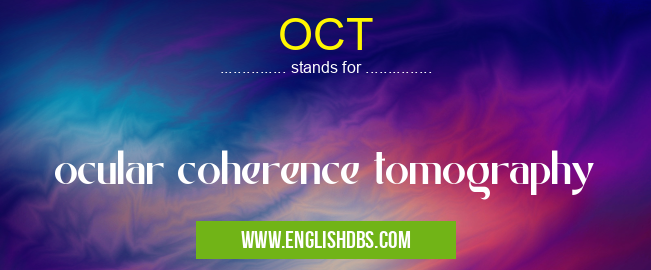What does OCT mean in MEDICAL
Ocular Coherence Tomography (OCT) is an imaging technology that has revolutionized the diagnosis and management of eye diseases. OCT uses light to create highly detailed images of the retina, which can be studied for signs of vision impairment caused by a variety of conditions and diseases. This non-invasive technology is widely used in ophthalmology today, giving practitioners a far more complete view of the condition of the eye than conventional imaging techniques.

OCT meaning in Medical in Medical
OCT mostly used in an acronym Medical in Category Medical that means ocular coherence tomography
Shorthand: OCT,
Full Form: ocular coherence tomography
For more information of "ocular coherence tomography", see the section below.
Essential Questions and Answers on ocular coherence tomography in "MEDICAL»MEDICAL"
What is Ocular Coherence Tomography (OCT)?
Ocular Coherence Tomography (OCT) is an imaging technology that uses light to create highly detailed images of the retina. It is a non-invasive technique used in ophthalmology to diagnose and manage eye diseases.
How does OCT work?
OCT works by passing light through the eye. The different reflections from different layers inside the eye are then collected, converted into electrical signals, and analyzed using computer algorithms to generate 3-dimensional images of the structures within the eye.
Is OCT safe?
Yes, OCT is very safe as it does not involve radiation or any other invasive procedures or substances. The procedure itself takes only a few minutes and causes no pain or discomfort to the patient.
What can OCT detect?
OCT can detect abnormalities inside the eye such as changes in retinal thickness or volume due to disease or other pathology, retinal breaks or detachments, macular holes, and abnormal blood vessels in the back of the eye. Additionally, it can be used to monitor other problems such as glaucoma and age-related macular degeneration over time.
Who should get an OCT test?
An OCT test may be recommended for patients with symptoms such as sudden vision loss, blurred vision, floaters (dark spots), flashing lights in their field of vision, photopsia (flickering), or metamorphopsia (distorted images). Additionally, an OCT test can help diagnose certain underlying medical conditions that have visual symptoms such as diabetes or stroke.
Final Words:
Ocular Coherence Tomography (OCT) has revolutionized how we diagnose and manage vision impairments caused by various diseases and conditions. With its high levels of detail and accuracy combined with its safety profile, it has become one of the most powerful tools available in ophthalmology today for assessing vision health accurately.
